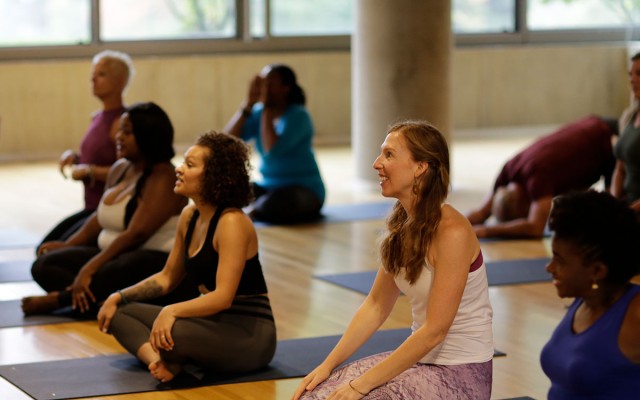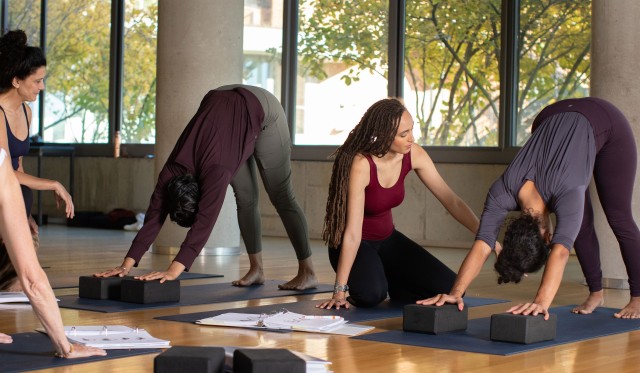The Kripalu Approach to Assisting

In training yoga teachers to offer adjustments and assists in class, the Kripalu School of Yoga has taken different approaches over the years. We’ve explored manipulative physical adjustments, shifted to the less invasive press-point system, and have always included in our methodology hands-off forms of assists, such as verbal, modeling, and offering props. We emphasized the necessity of asking permission before engaging with a student physically. It seemed obvious to us that, to ensure the safety of the whole being, individuals needed to understand a teacher’s intentions, and to know they would not lose agency over their bodies just because they showed up in one of our yoga classes.
Even so, most of our teachers didn’t offer any form of hands-on adjustment. Hands-off teaching has a long history in our tradition. In 2018, our teachers stopped offering any physical adjustments in our on-site guest yoga classes. Beginning in 2020, the School of Yoga will no longer teach 200-hour teachers-in-training to offer hands-on assists.
There is an inherent power differential between the student and the teacher, no matter how humble the teacher, and that power is magnified during adjustments. We want students to retain authority over their own bodies.
The Pros and Cons of Hands-On Assists
Many people enjoy receiving physical adjustments in yoga class. I’ve had the experience of being maneuvered into different shapes by skilled teachers who showed me what my body could do—and it was impactful to realize those possibilities. And I think it’s important to note that the times I received these assists, I was studying with the teacher in a workshop, or took classes with them over time. In other words, the teacher knew me, and that made a difference in terms of my comfort level. It also made a difference because I had evidence to show that this teacher had expertise and clear intentions; I could trust them.
Just as many of us have had positive experiences with hands-on assists, we could also tell stories of inept adjustments and injuries as a result of assists. As teachers, we recall times where we didn’t give an adjustment as skillfully as we had intended. I’ve been on the giving end of a bad assist—it was well intentioned but, unfortunately, I believed I knew more than I actually did. Fortunately, no one was hurt. That encounter was one of the strongest lessons of my teaching journey, and the most developmental. I learned that, when guiding a yoga class, it’s never about the teacher.
Many teachers will say that assisting someone when they are misaligned is essential, for safety’s sake. However, the hyperawareness of alignment common in contemporary Western yoga practice and teaching can be both a help and a hindrance. All of us carry baggage, whether we know it or not, and yoga teachers must stay cognizant to the impact of moving into the subtle body (the energy body) when addressing the physical body. It’s important to consider the benefit versus the risk, and to understand that it could be “safer” to forgo an alignment correction and avoid invading a student’s personal space—even if permission has been given. In a class setting, it’s impossible for the student to ascertain precisely what the adjustment will entail, so they don’t really know what they’re agreeing to. What feels okay to them at one moment might not continue to be as the adjustment and posture change. Plus, a student may seem agreeable on the surface, but the teacher can’t know what is arising within them, and often the student may not know either.
Alternative Assists
Teachers have at their disposal a toolkit of other options for guiding students into alignment. For example, they can “adjust” a student simply by speaking clearly and offering anatomically correct cues. Offering a student a prop and speaking to them directly about their body's position is another option. It’s important to keep in mind that most professions that utilize touch have extensive educational standards and licensure. In yoga, a 200-hour certification permits you to manipulate another’s body. What about yoga, as opposed to other practices, makes teachers think that this is okay?
In the Kripalu School of Yoga, we believe that a yoga class has the potential to enhance body-mind integration and expand awareness. For that potential to be realized, teachers need to allow the individual’s unique process to unfold of its own accord. We shift from the form of the posture, and cultivate curiosity about its content. We let people express Down Dog the way it was meant to flow in their particular body. We shift the yoga class from teacher-centric—the teacher’s ideas of what is correct and what isn’t—to student-centered, allowing individuals to have their expression and their experience of yoga without interference.
Thousands of people today come to yoga, for just as many reasons. That we have lots of ways to practice and guide yoga is a testimony to the strength of the practice. But yoga requires that teachers and studios remain vigilant to the question, What is the purpose of a yoga class? Without such an ongoing inquiry, teachers risk forgetting that yoga classes aren’t about what teachers know or what we can do.
It is Kripalu’s aspiration to hold a distinct space in yoga. We want our classes to invite people to show up as they are; explore the multitude of sensations, thoughts, and feelings that arise within the practice; and enjoy being guided by a skilled teacher, without concerns about how that teacher will interact with their body. We believe that this assurance will help students attain the deepest levels of relaxation and will best serve their inner development and growth.
Cristie Newhart, former Dean of the Kripalu School of Yoga, is a dynamic yoga teacher who imbues her classes with meditative inquiry, detailed alignment principles, and playful humor.
Full Bio and Programs
